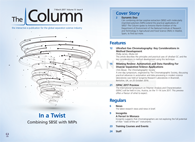Ultrafast Gas Chromatography: Key Considerations in Method Development
Ultrafast gas chromatography (UFGC) offers analysis times 5–20 times faster than conventional GC, with comparable sample capacity and resolution. These factors along with greatly reduced energy consumption make UFGC a valuable approach to explore in many application areas. This article describes the principles and practical uses of ultrafast GC and the key considerations in method development using this technique.
Photo Credit: Svetlana Foote/Shutterstock.com

Phillip James, Ellutia Ltd., Ely, Cambridgeshire, UK
Ultrafast gas chromatography (UFGC) offers analysis times 5–20 times faster than conventional GC, with comparable sample capacity and resolution. These factors along with greatly reduced energy consumption make UFGC a valuable approach to explore in many application areas. This article describes the principles and practical uses of ultrafast GC and the key considerations in method development using this technique.
Gas chromatography (GC) is a core technique for chemical analysis and one that is commonly used in analytical laboratories globally. The principle of GC was first conceived in 1941 by A.J.P Martin and R.L.M. Synge and the process involves adsorption of gases and low boiling hydrocarbons (1). Ultrafast gas chromatography (UFGC) has the power to offer analysis times that are 5–20 times faster than conventional GC, with comparable sample capacity and resolution. UFGC has increasingly become a valuable tool for researchers across a number of application areas. One example of this value is a method developed by a motor racing team using ultrafast GC to monitor engine wear in their race cars during a race. The GC system was used to look at the breakthrough of fuel into the engine oil. Ultrafast GC was a perfect tool for this application because the fast cycle time is ideal for a race environment. This article will describe the principles and practical uses of ultrafast GC and the key considerations in method development using this technique.
What is UFGC?
Understanding traditional GC is important to appreciate the dynamics of ultrafast GC. Conventional GC uses 15–60-m columns with internal diameters up to 0.53 μm or, sometimes, packed columns. Heating rates are typically from 1 °C/min to 40 °C/min, and analysis times run from 15 min to 90 min or more. Fast GC uses columns with very small diameters, typically 0.1 mm, and short column lengths, such as 10 m. Fast GC yields good resolution and improved speeds over conventional GC at the cost of sample capacity, with run times at an average of just a few minutes.
Ultrafast GC uses shorter columns with larger internal diameters, which helps overcome the capacity problems experienced with 0.1-mm columns and allows for faster ramp rates. The column is usually directly heated in a column compartment without the use of an air-blown column oven. The objective is to heat as little mass as possible so that ramp rate increases and cool-down can be accomplished quickly. The cycle times for UFGC are 5 to 20 times faster than for conventional GC, with ramp rates of 1000 °C/min possible. However, for practical reasons, ramp rates in the range of 60 °C/min to 200 °C/min are usually used with run times less than a minute to a few minutes.
The column can be heated to much higher temperatures with its upper temperature the limiting factor, but the temperature inside the column compartment is typically only about 90 °C, which allows for cool-down in 30–90 s. Rapid cool-down in UFGC requires significantly less energy than conventional GC, which can be a real benefit when large numbers of samples are being analyzed.
UFGC: Applications and Examples
UFGC can be particularly useful for applications requiring rapid and repeated analysis, including screening analyses. UFGC offers significant advantages for the screening analysis of environmental, petrochemical, and pesticide samples because results can be turned around rapidly-even same day-and analyses can be repeated quickly for confirmation of results.
In reaction monitoring, UFGC is used in motor racing to analyze sump oil for fuel breakthrough to help determine engine wear. The technique is also useful in the analysis of waste streams in pharmaceutical manufacturing and in testing permeation breakthrough of chemicals in warfare suits and other types of protective clothing. In clean-up monitoring, industries such as essential oil manufacturing that require clean processing equipment use UFGC for fast determination and repeated analyses of possible residue materials. The fuel oil separations shown in Figure 1 compare a conventional GC analysis at 35 min with a very similar analysis by UFGC in just 150 s.

UFGC Method Development
It is important to understand the basic principles of UFGC because method development in this instance can seem contrary to the conventional GC method development. An application run on a 30-m column can usually be run with equivalent results via UFGC. If a method requires a 60-m column or extra-thick films to achieve the required resolution, ultrafast GC may not achieve the needed resolution, but, in that case, a screening method can be developed.
Start with a relatively slow ramp rate such as 60 °C/min using hydrogen as the carrier gas at either a constant pressure of 8 psi or a linear velocity of 50 cm/s and a 7-m thin-film 0.18- or 0.25-μm i.d. column. If needed, the column can be shortened if all peaks do not elute in the required time. The temperature ramp should be started about 10 °C above ambient. Adjust the temperature range to elute all components in the sample, which can usually be accomplished in 2–3 runs. The top temperature needs to be as low as possible and the scientist would need to mark peaks of interest that will require good resolution.
Following this, for the first single-ramp chromatogram, the carrier velocity should be adjusted until the best separation of the peaks of interest is achieved (typically up to 120 cm/s). Then, by using a constant pressure starting at 8 psi and adjusting up and down in small increments on each run, it will achieve the best resolution in different parts of the chromatogram. This process typically requires about 10 runs. Once the best pressure programme is achieved, the temperature ramping programme can be adjusted in areas of the chromatogram to speed up the separation as a whole. Eventually, resolution will begin to deteriorate. In this case the ramp rate should be backed down slightly. Finding the best ramp rate can typically take about 20 runs. Most successful UFGC methods are about 4 min with a 90-s cool-down. The entire optimization process might take about 35 runs of 5 min each.
The Future of UFGC
UFGC is an advancement of the technology and method from typical GC, which is a core technique for chemical analysis in analytical laboratories worldwide. UFGC offers analysis times that are 5–20 times faster than conventional GC, with comparable sample capacity and resolution. The next three to five years will see columns optimized for UFGC. Faster multichannel detectors are being developed that will improve detection capabilities, including time-ofâflight mass spectrometry, infrared absorption spectroscopy, atomic emission detection, and far-UV absorption spectroscopy. Advances in detection and fully integrated systems on the horizon will help move UFGC into common use. Laboratories can smoothly transition into UFGC with available gas chromatographs that include a range of column configurations to be used, along with the conventional oven that automatically calibrates ultrafast columns.
Reference
- Dhruba Charan Dash, Analytical Chemistry (PHI Learning Private Limited, New Delhi, India, 2011).
Phillip James is Managing Director at Ellutia. He has been involved in the gas chromatography field for over 40 years. After graduating from Loughborough University (UK) in 1976, he began his employment in the chromatography industry as a design engineer at Pye Unicam in Cambridge (UK), which later became Philips Analytical. His career at the company progressed for 18 years, and he eventually became the head of the chromatography division. In 1994 he left this role to start Ellutia.
E-mail:info@ellutia.com
Website: www.ellutia.com

New Method Explored for the Detection of CECs in Crops Irrigated with Contaminated Water
April 30th 2025This new study presents a validated QuEChERS–LC-MS/MS method for detecting eight persistent, mobile, and toxic substances in escarole, tomatoes, and tomato leaves irrigated with contaminated water.

.png&w=3840&q=75)

.png&w=3840&q=75)



.png&w=3840&q=75)



.png&w=3840&q=75)










